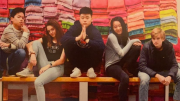We’ve all gone through it, some of us more than others. Each of us has spent one week of the school year learning about something new, fun, and interesting, and for that one week in January, all of us have found that learning doesn’t have to be in the curriculum.
Intersession gives IMSA students a chance to explore new topics or learn more about what they already know. Some intersessions, such as Chicagoland Museum Tour, are recurring favorites and heavily attended each year. Some just completed their first ever session. So what makes or breaks an intersession? Why are some courses offered every year while others are only offered a couple times? And how do new intersessions make the cut?
One of the new intersessions this year was Death Note and Philosophy, led by Dallas Eckman (’14) and Sunny Shah (’14). “I opened the email asking for intersession applications and asked my roommate Dallas if he wanted to teach one with me,” says Sunny. “We didn’t really have an idea in mind, but we both liked teaching, so why not? The stars were obviously aligned in our favor, so we quickly asked the lovely Dan Riemersma (residential counselor) to sponsor us and wrote a seven page application about the learning outcomes from discussing various literary, ethical, and philosophical aspects of Death Note.” Lot of work? Definitely. But the end product of the session makes the time worthwhile.
A lot more goes into bringing a new intersession to life than effort from the instructors. Ellen Heinz is an administrative team member who plays a large role in intersession. She takes charge of “setting up the proposal process for presenters, setting up the request process for students, scheduling students in sessions, and handling logistics involved with sessions,” among other responsibilities. Heinz has seen more than her fair share of intersessions.
So what makes a ‘good’ intersession? “Activities,” she replies, “whether it is going somewhere or making something. Students seem happiest being active and not listening to lectures all day.” A prime example would be the wildly popular Chicagoland Museum Tour. It had 72 applicants this year alone and is a recurring favorite. The new intersession trip to California’s Silicon Valley was also a popular choice among students.
What other qualities must an intersession have a shot at being held again? “We look at the merit of the session in terms of opportunity for students,” says Diane Hinterlong. “We also look at whether we feel the presenter is qualified.”
Then why are some attractive sessions often only occasionally instead of every year? “The presenters volunteer what they would like to do for an intersession,” answers Hinterlong, “and so even though the students might like it year after year, maybe the presenters want an opportunity to present something different. We want the presenters to do something they feel passionate about as well.”
There are also intersessions that are proposed but never make it to the virtual pages of intersession sign-up. According to Hinterlong, a proposal may be denied if the reviewing board feels that the presenter is not qualified or if it is “not detailed in terms of how they’ll engage students and what they do.” She continues that “…beyond that, the others that don’t run are based on student demand.”
The result of all this effort from faculty, staff, and presenters is a unique opportunity for IMSA students. Most students would agree that it is not only fun but perhaps crucial to the IMSA experience. As Heinz puts it, “it is a nice transition back to school after break… and it is a nice way for students to interact with faculty, staff and alumni presenters.”
“I strongly recommend teaching an intersession senior year,” says current senior Sunny Shah. “You don’t have to be an expert, just find something you like to talk about and have faith.”





Be the first to comment on "Intersession 2014 – Behind the Scenes"